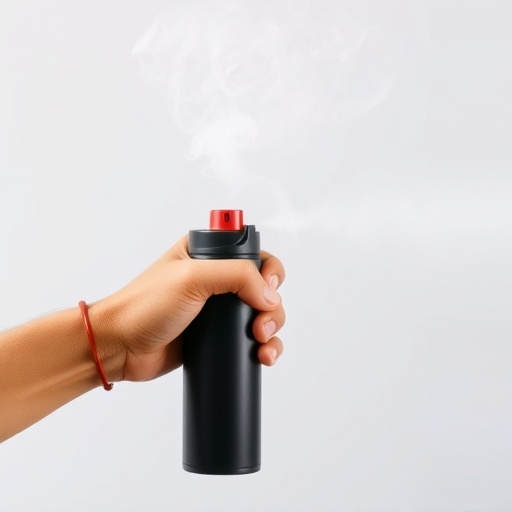The shelf life of pepper spray after opening depends on environmental factors like heat, sunlight, moisture, and storage history. Proper cool, dry storage extends its effectiveness from 6-12 months to up to 2-3 years. Regular inspection for signs of spoilage is crucial, as is keeping opened cans away from direct light for maximum potency preservation.
In the realm of public safety, understanding the capabilities and limitations of inflammatory spray for riot control is paramount. This article delves into the intricacies of pepper spray composition and its efficacy, exploring factors that significantly impact shelf life after opening. We uncover optimal storage practices to preserve potency, detail signs of spoilage, and emphasize safety precautions. Additionally, a comparative analysis of commercial brands and their lifespans provides valuable insights for law enforcement agencies and first responders.
- Understanding Pepper Spray's Composition and Efficacy
- Factors Influencing Shelf Life After Opening
- Storage Best Practices for Optimal Retention
- Detecting Signs of Spoilage and Safety Precautions
- Comparative Analysis: Commercial Brands and Their Lifespans
Understanding Pepper Spray's Composition and Efficacy
Pepper spray, a common tool in riot control and law enforcement, is designed to incapacitate individuals temporarily through irritation of the eyes, respiratory system, and skin. Its composition typically includes capsaicin, a chemical derived from chili peppers, dissolved in a carrier solution. This potent irritant triggers a burning sensation, leading to temporary blindness, coughing, and difficulty breathing.
The efficacy of pepper spray is well-documented, but its effectiveness can vary based on factors like the concentration, weather conditions, and the target’s tolerance or immunity. Regarding Pepper Spray shelf life after opening, manufacturers often suggest a reduced period of usability due to potential degradation of the chemical compound. Proper storage, including keeping it sealed and in cool, dry places, can extend its viability, but users should be aware that opened containers may have shorter lifespans compared to unused stock.
Factors Influencing Shelf Life After Opening
The shelf life of pepper spray, especially after opening, is influenced by several key factors. One of the primary considerations is environmental conditions. Prolonged exposure to high temperatures or direct sunlight can significantly reduce its effectiveness and shorten its useful lifespan. Proper storage in cool, dry places is essential to maintain potency.
Another crucial factor is how the pepper spray is handled after opening. Exposure to moisture, whether from humidity or rain, can degrade the active ingredients. Using it promptly after opening and ensuring the container remains sealed when not in use can help preserve its quality. Additionally, factors like manufacturing date and storage history play a role; newer batches typically have longer shelf lives, and consistent storage practices enhance overall durability.
Storage Best Practices for Optimal Retention
Proper storage is paramount for maintaining the effectiveness and potency of inflammatory spray, especially after opening. To maximize its shelf life, store the pepper spray in a cool, dry place, away from direct sunlight or extreme temperatures. Keep it sealed tightly to prevent moisture ingress, which can compromise its performance.
For optimal retention, consider storing the spray at temperatures between 50-70°F (10-21°C). Avoid placing it near heat sources or in areas with high humidity levels, as these conditions can accelerate degradation. Additionally, keep the spray out of reach of children and unauthorized individuals to ensure safety and maintain its integrity for when it’s needed most during riot control situations.
Detecting Signs of Spoilage and Safety Precautions
After opening a can of pepper spray, it’s crucial to be aware of its shelf life and potential signs of spoilage. Unlike unopened products, opened cans are exposed to oxygen, moisture, and other environmental factors that can accelerate degradation. Pepper spray manufacturers typically provide a shelf life estimate after opening, usually ranging from 6 to 12 months, but this can vary based on storage conditions.
To ensure the effectiveness and safety of your pepper spray, regularly inspect it for any signs of spoilage. Look for changes in color or consistency, unusual odors, or any visible debris. If you notice any such issues, dispose of the spray responsibly and acquire a fresh unit. Always store opened cans in cool, dry places away from direct sunlight to maximize their shelf life and maintain optimal performance when needed.
Comparative Analysis: Commercial Brands and Their Lifespans
When considering pepper spray for riot control, a key factor is the product’s shelf life after opening. Unlike some commercial brands that boast indefinite shelf lives, real-world usage demands we look at practical durations. Many reputable manufacturers suggest their products remain effective for 2–3 years following opening, with proper storage. However, this can vary based on active ingredients and formulation, with some specialized sprays offering extended lifespans.
A comparative analysis of commercial brands reveals significant disparities in claimed shelf lives. It’s crucial to read product literature carefully; some companies may promote long-lasting properties, but these claims should be scrutinized. Ensuring your riot control pepper spray remains potent is vital for safety and effectiveness on the ground. Remember that once opened, the clock starts ticking, and proper storage conditions – cool, dry, and out of direct sunlight – are paramount to maintaining maximum efficacy.
Pepper spray, a potent tool in riot control, requires proper handling and storage to maintain its effectiveness. By understanding the factors influencing its shelf life after opening, such as composition, storage practices, and potential spoilage signs, users can ensure optimal retention of its potency. A comparative analysis of commercial brands highlights the importance of choosing reliable manufacturers who adhere to strict quality standards. Ultimately, awareness of best practices and proactive measures can maximize the reliability and safety of pepper spray during operational deployment.
